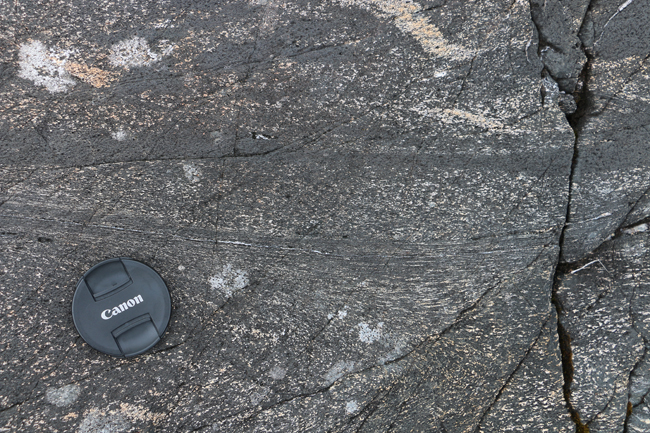In 1970, John Ramsay and Rod Graham published a paper about shear zones1. I cited their foundational work of these structures, essentially “ductile faults,” in my M.S. thesis, despite the fact that the Ramsay & Graham example shear zones were in otherwise homogenous plutonic rocks, and were a few centimeters wide. In contrast, my study area was the Sierra Crest Shear Zone System, a broad ribbon of deformation several kilometers wide and 100+ kilometers long, and deforming dozens of different lithologic units.
When I was preparing to travel to Scotland this past summer, it occurred to me that I ought to try and visit the original site, a spot called Castel Odhair, on North Uist, in the Outer Hebrides of Scotland. I made some inquiries and got details (including a gracious email from Rod Graham himself) about how to get there. But as it turned out, getting out to Lewis and back would take a lot of time and my schedule was already packed. Fortunately, Con Gillen let me know about another spot showing similar shear zones in similar rocks on the Scottish mainland, Rubh’ an Tiompain.
I had enough time in my schedule to make a solo morning expedition to this headland near Tarbet, and I found the outcrop without too much trouble. It wasn’t Castel Odhair itself, but it was pretty much the same thing, and I was glad to be able to visit with my camera. Here’s a look at these pavement exposures of gabbro cut by numerous small ductile shear zones:




Good looking rocks, right? You might compare these images with those I took in southern Ontario – similar scale in similar rocks.








The outcrop had been scarred by a drilling campaign:


Now for the post-script…
When I got back to the States, I was able to dig into the structural geology teaching collection accumulated by my colleague Declan De Paor and his wife Carol Simpson, both recently retired from Old Dominion University. Carol had collected some samples from Castel Odhair itself, and now I own these samples! Rod Graham was Carol’s undergraduate advisor at Swansea and she collected these samples on a field trip with him. I have imaged them on the GIGAmacro to share them with you:
Link 1.49 Gpx GIGAmacro by Callan Bentley
Link 0.91 Gpx GIGAmacro by Callan Bentley
Link 0.92 Gpx GIGAmacro by Callan Bentley
These GigaPans thus far show “half shear zones” showing the transition from equigranular undeformed gabbro to highly sheared and foliated gabbro. But they don’t really convey visually the same sort of ‘sense’ of shear in a tabular zone of foliated rock that you get with the Rubh’ an Tiompain outcrop photos. So check this out: I faked a “complete” shear zone image by doubling one of the previous images in Photoshop. Here’s the result:
Link 1.29 Gpx GIGAmacro by Callan Bentley
Last, for lithological contrast and structural comparison, here’s a similar sized shear zone cutting through a granite, also from Declan and Carol’s collection:
Link 1.29 Gpx GIGAmacro by Callan Bentley
Someday, maybe I’ll be able to make a structural geology pilgrimage to Castel Odhair, but in the meantime, these images will do.
____________________________________________
Work Cited
1: Ramsay, J.G., and Graham, R.H., 1970. Strain variation in shear belts. Canadian Journal of Earth Sciences 7, 786-813.


Erratum:
An earlier version of this post misidentified the island on which Castel Odhair is located. It has been fixed thanks to a tweet from Helen Blake. I am grateful for the correction. -CB